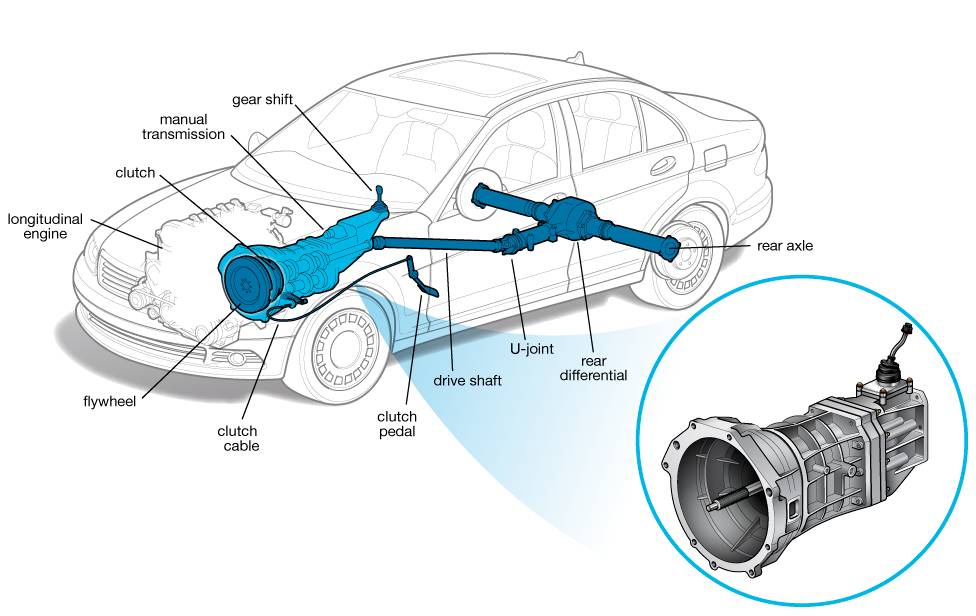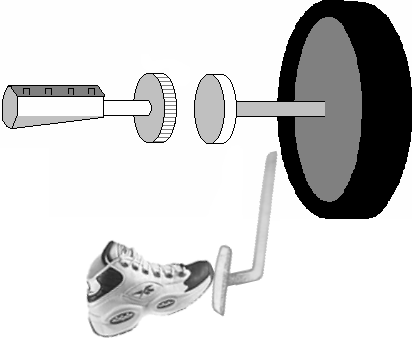Long story short: I’m (24M) American, and I’m visiting my long-distance Romanian boyfriend for the first time soon. In Romania, most cars are manual - including all the ones owned by my boyfriend’s family (I’ll be staying with them). I’ve never driven a manual before. His dad told me he can give me a quick lesson, and that I’m welcome to use their cars if I want; otherwise, I can rent an automatic. I don’t have access to any manual cars here in the U.S. to practice on, so I’m not sure what to do.
Make sure your driving licence is valid for driving manual in Romania. Here in the UK if you pass your test on an automatic, you’re only licenced to drive automatic, and if you drive manual then you are breaking the law and your insurance is invalid.
Maybe there’s no issue but it’s worth checking.
If you’re anything like me, you have an easier time understanding how to do things if you understand how they work.

See the clutch in the diagram? The clutch is the part that actually connects the engine to the transmission. Mechanically, it’s almost like a brake but reversed. To keep things simple, the engine side has a disk and the transmission side has a disk. When you press in the clutch pedal all the way to the floor, those disks will be totally separated and the engine can rev however you like because it’s not connected to the rest of the drivetrain. As you release the clutch slowly and smoothly, you’ll feel the clutch “bite”: that’s when the two disks make contact, but it’s very light contact at first so they’ll be sliding against eachother (think of gently applied brakes). The friction will still spin the transmission a little bit though, and if you’re in gear the car will start to roll. As you smoothly release the clutch pedal more and more, the two disks will press into eachother more and more firmly, sliding less and less, until you’ve fully released the clutch pedal and the disks aren’t sliding at all; the engine is totally connected to the rest of the drivetrain.

With most cars I recommend for a first step starting the car rolling on flat ground using only the clutch, no gas. With some cars you might have to give it a little gas, but in my experience most cars have enough idling torque to start from a stop by releasing the clutch very slowly and smoothly, I’m talking like 5 seconds or more to go from clutch fully to the floor and car stopped to fully released and rolling. Once you’ve done that a few times and you’re starting to get a good feel for how the clutch behaves, you can start adding some gas to start more quickly and release the clutch quicker (but still smoothly).
The second thing to know once you’re rolling is that the engine needs to run within a certain rev range, if you let it get too low (below like below idle rpms), you’ll start to bog and maybe even stall, too high and you’ll hit the rev limiter or possibly damage the engine if it doesn’t have one. Knowing that, I think that timing shifts and knowing when to press the clutch becomes pretty intuitive, really all you need to do is press the clutch before the engine gets out of that rev range, shift up or down in the direction that gets you back into it (or maybe into neutral if you’re stopping), and smoothly release. When in doubt just press the clutch, it won’t hurt anything it just cuts power to the transmission.
TL;DR: The clutch connects the engine to the transmission. Press it in to disconnect the engine from the transmission, release smoothly to gradually reconnect. Start out only using the clutch to to get the car rolling, then once you’ve got the hang of that try adding a little gas to get rolling quicker. Shift in a way that the engine is always within it’s rev range, i.e. press the clutch in and begin changing to a more appropriate gear before you start redlining or bogging.
I’m a car guy and learning manual for me was embarrassingly slow. I’m good at it now and my daily is a manual but when I was learning it was a total disaster.
It’s really easy, there’s just a few things that you have to remember and there is a bit of muscle memory. I suggest watch a bunch of videos on how to do it properly on YouTube and just practice in a parking lot for like 2-3 hours and you should be completely fine to drive. You might not have cars to practice on where you live, but you might be able to just do it when you get to Romania. Just go for like two hours to practice before you start driving around.
Driving a manual is a bit tricky to start with but minimum practice and you’ll learn everything you need to know. Everything else is experience. Once you’ve driven it for a while, especially through various weather conditions, you’ll find that you have more control of the vehicle when driving a manual stick shift. Even three on the tree makes you more free.
I miss my manual a little bit sometimes, especially for shorter drives it could be fun.
Long drives with frequent speed changes, traffic or hills kinda sucked though. I had a pretty crappy Kia though lol curious how a higher end manual feels by comparison.
I never minded manual until I got the crappy little Swift I’m driving now. It only seems to respond to swearwords.
Its pretty easy but takes time just like any machine operation.
It’s incredibly easy if you have any semblance of finesse with your feet. Rev up the engine, ease off the clutch until the rpms start to dip, then give it more gas and ease off the clutch until you’re fully going.
Before you even mess with the clutch play with the throttle. Get good and holding it at 1500 rpm, 1750 rpm, 2000 rpm etc. throttle management is just as important as the clutch.
It’s not too bad. You can get passable in a manual with less than a day of practice.
There are a lot of good tips in here, but I’ll add a few that seem to be missing/less prioritized.
Practice rev matching while down shifting. You’ll be a lot more comfortable with the car if you can get into a lower gear faster. This will allow you to pass and accelerate smoother and with confidence.
Practice recovering from a stall (although you’re probably going to do this accidentally anyway). Foot on brake, push the clutch all the way in, shift to neutral or 1st (I prefer 1st to get into gear faster), start the car, and get moving. This process should be fairly automatic and done within a second or two.
On that note, don’t worry about stalling the car. It feels terrible, and embarrassing, but it’s not really damaging the vehicle (might wear out the engine mounts a little faster, but no one really cares).
Most important, have fun!
Check local driving schools. They might have one.
If you’re like me then you drive it right away no problem. if you’re like my sister svenika then you will never drive it once
hm i think you will need at least lime 3h of controlled practice tp get used to it. My gf learnt to drive automatic and after 3 lessons of 30min, she can barely start moving the car by herself lol.
Like riding a bike. If you’ve never done it it’s going to be hard but give it a few hours of deliberate practice you’ll be fine.
And again like with a bike you should probably practice away from traffic to begin with…
Learning to drive a stick is really easy if you have somebody to teach you well, but waaay too many people are like, “here, keep fucking up until the car doesn’t go anymore or you figure it out, whichever comes first”.
Hardest part is getting the car to start moving from stopped. Changing gears once moving, you can fuck it up a bunch and nothing much happens except funny engine noises and the owner starts making constipated-looking facial expressions. But if you fuck up starting from stopped, then you lurch around a bunch, stall the engine, and don’t go anywhere.
To get started from stopped, without horrible lurches or stalls, do like this FROM A FLAT PLACE – don’t try anything with hills until you can make the car go on the flat first:
-
IMPORTANT: adjust your seat so you can easily push the clutch (left pedal) in – all the way to the floor – without uncomfortable stretching
-
In your driveway when there’s nobody going to honk at you, start the car, put it in neutral, and practice pushing the gas pedal just enough to hold the engine at 3000 RPM or so. Not making crazy racing noises, just a nice steady “the engine is running normal-fast-ish” and hold it that way. Practice a couple times until your foot and your ear know what it feels like
-
Put it in gear without moving – gas off, clutch in and put the car in first gear.
-
Gas on, steady at 3000 RPM, slooooooowly let the clutch out until you can just barely feel the clutch is engaged. Engine revs down a little bit, car starts crawling forward. Practice that a couple times, just let the clutch out until it barely starts doing anything, then put it back in, until your foot knows what it feels like.
-
Now do it again, engine held at steady revs, clutch out until just barely engaged, then let the clutch out just a little bit more, so the car wants to crawl, and hold the clutch there. Car starts crawling. Keep the engine steady like you’ve been, let the car start crawling, don’t even change anything, just let the car crawl. It will slowly accelerate until you’re moving at some steady 1st-gear speed. Once it’s come up to (slow) speed you can let the clutch out the rest of the way.
-
Congratulations you moved a car
IMPORTANT: adjust your seat so you can easily push the clutch (left pedal) in – all the way to the floor – without uncomfortable stretching
The person of the driving school who thought me how to drive told me to push in the clutch completely, and put your seat in a way that you would have your knee bent just a tiny bit.
practice pushing the gas pedal just enough to hold the engine at 3000 RPM or so. Not making crazy racing noises, just a nice steady “the engine is running normal-fast-ish”
Depending on the type of car, this might usually be somewhere between 1500 and 2000 RPM (even lower for a diesel), 3000 RPM are more typical for a sports car.
especially in a diesel even 1500 is too much.
Overall (and this is from a lifelong manual driver), I go much more by feel than I do any particular number on the tach, under normal driving circumstances.
i can imagine. i’ve mostly had automatics, but when i was looking for my first car one of the candidates was an old saab with no tacho, it only had little indicators on the speedometer for where to shift. in that situation i imagine muscle memory is created pretty quickly.
There’s some of that, but you really do get a feel for the car, where it likes to be, how it likes to be treated/driven, where its limits are, and so on. As others have said: it absolutely does help you forge a more detailed perception of what your car is doing, and where the limits really are.
oh i know, i learned to drive on manual since most cars are manual here, i just haven’t owned one myself.
that said, with electric power-steering and throttle-by-wire, there’s no feel to get. it’s all just dead, no matter how fun the clutch is.
Indeed.
It’s also typical for a Honda fit
-
Why do you need to drive in the first place?
Yeah, just take their well known public transport system, or take six months and tour the country by bicycle. \s
Can’t his boyfriend drive the car




